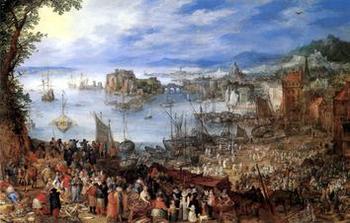Subproject 1: Portus and Emporium: On the Visual Topos of Long-Distance Maritime Trade in Netherlandish Painting and Graphic Arts, 1550–1680
Jan Brueghel d. Ä., Großer Seehafen mit Portät des Künstlers und seiner Familie, Öl-Holz, 59x92 cm, 1603.
Image Credit: München, Bayerische Staatsgemäldesammlung Alte Pinakothek.
(PD Dr. Joachim Rees)
This subproject of the research project is dedicated to the genesis and transformation of the portus motif in the art of the southern and northern Netherlands. The iconological relationships of the harbor-city structure will be outlined in a study composed of three steps:
1. Portus Novus: The Emergence of a Mercantile Harbor Iconography in Antwerp, 1550–1600: In a first step, the formation of the motif of the portus north of the Alps will be worked out using the example of the municipal and communal politics of promoting the image of Antwerp and in the artistic work of exemplary representatives of the Antwerp school of painters.
2. Portocracy: The Litoral Topos in the Corporate Image of the Dutch East India Company, 1602–1660: Reshaping the motif of the portus from a visual element of the laudatio urbis mercatorum into a quasi-imperial symbol of power will be the focus of a second step in the study. The main venue of this development was Amsterdam, which from 1602 onward was the seat of the central management committee of the Vereenigde Oostindische Compagnie (VOC; Dutch East India Company).
3. Porto Antico: Mediterranean Harbor Nostalgia and a Colonial Crisis in Dutch Painting, 1650–1680: The interpretation of the portus as a liminal space where territorial boundaries drawn between the immediate vicinity of one’s own culture and the distant regions of the foreign become unclear will be studied in depth in the final step of the study. The focus here will be on the boom of Italianate harbor scenes in Dutch painting in the decades between 1640 and 1680.


